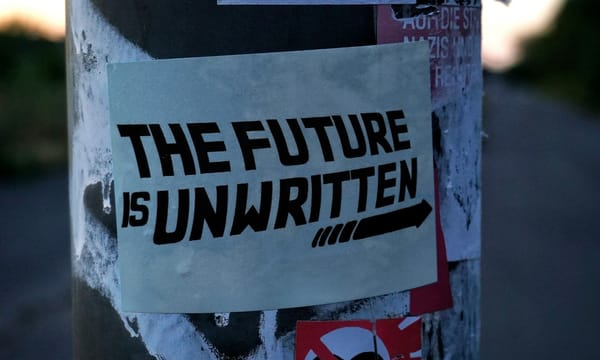Abolition Feminism & the Black Radical Tradition: How to Fight Authoritarianism at Its Roots
Mainstream narratives treat authoritarianism like a glitch in democracy. But thinkers in the Black radical tradition—like Cedric Robinson, W.E.B. Du Bois, and Angela Davis—show that authoritarianism is a feature of U.S. governance, not a bug.

Authoritarianism Is Structural, Not Just Political
Mainstream narratives treat authoritarianism like a glitch in democracy. But thinkers in the Black radical tradition—like Cedric Robinson, W.E.B. Du Bois, and Angela Davis—show that authoritarianism is a feature of U.S. governance, not a bug.
Cedric Robinson coined the term racial capitalism, arguing that capitalism was never colorblind. It requires racial hierarchies to function. From slavery to Jim Crow to the prison industrial complex, domination has always been racialized, gendered, and profitable.
Abolition feminism (led by figures like Ruth Wilson Gilmore and Mariame Kaba) extends this analysis by connecting racial capitalism to patriarchy, showing how authoritarian power is maintained through control over gender, sexuality, and reproduction.
Authoritarianism in America didn’t begin with Trump, it began with chattel slavery, settler colonialism, and the legal disappearance of Black and Indigenous lives.
The Authoritarian Infrastructure: Policing, Prisons & ICE
Modern authoritarianism doesn’t need tanks in the street when it has ICE vans, body cams, and predictive policing algorithms.
- Policing in the U.S. evolved from slave patrols and settler militias.
- Prisons function to disappear people labeled “undesirable,” disproportionately targeting Black, Brown, disabled, queer, and poor communities.
- ICE enforces racialized borders, separates families, and uses surveillance to control entire populations—often with impunity.
Under the Trump administration:
- ICE forced sterilizations were reported at Irwin County Detention Center (Project South, 2020).
- Border agents detained trans women in solitary confinement, denying them medical care and exposing them to abuse.
- Reproductive and trans rights were strategically dismantled under the guise of “religious freedom” and “national security.”
These are not isolated injustices. They are authoritarian mechanisms designed to punish, disappear, and control.
Reproductive Justice & Trans Liberation Are Resistance
Carceral feminism often advocates for harsher laws in the name of safety. But abolition feminism warns: You can’t end gender violence by expanding state violence.
- Reproductive justice, coined by Black women organizers in the 1990s, demands the right to have children, not have children, and parent in safe communities.
- Trans liberation resists state-enforced binaries and the criminalization of identity.
Both movements challenge authoritarianism by rejecting state control over bodies and redefining what freedom actually means.
Under authoritarian regimes—especially those with Christian nationalist backing—control over reproduction and gender expression is central. That’s why abortion bans, forced birth policies, anti-trans legislation, and “don’t say gay” bills are so heavily pushed.
The authoritarian state fears bodily autonomy. That makes reproductive justice and trans liberation frontlines of resistance.
Collective Struggle, Not Individual Reform
The Black radical tradition teaches us that liberation is always collective—not given, but fought for. From the Underground Railroad to prison abolition today, change has come from those most targeted by authoritarian systems.
- Assata Shakur reminds us: “We must love and protect each other. We have nothing to lose but our chains.”
- Mutual aid projects, Black trans-led survival funds, and undocumented youth networks aren’t side efforts. They are core resistance tactics.
- Solidarity means following the lead of those most impacted—not co-opting their struggles into palatable soundbites.
Authoritarianism thrives when we are isolated. Abolition builds power by weaving care into resistance.
Abolition as Imagination: Dismantling & Rebuilding
Angela Davis writes that “freedom is a constant struggle.” But it’s also a creative act.
Abolition feminism is not only about tearing down what harms—it’s about building what sustains:
- Housing cooperatives
- Community-based mental health
- Conflict mediation without police
- Trans-inclusive healthcare
- Decarceral reproductive care
Authoritarianism shrinks the possible. Abolition expands it.
Historical & Real-Time Parallels
The Trump administration didn’t invent authoritarian tactics—it refined them using old playbooks:
Past tactics and Trump-era parallels
- Disinformation COINTELPRO “Stolen election” lies
- Family separation Indigenous boarding schools, slavery ICE child detentions Medical abuse Forced sterilization of Black, Latinx, Indigenous women ICE sterilizations
- Targeting gender & sexuality Lavender Scare, anti-abortion campaigns Trans bans, Roe reversal
- Mass incarceration War on Drugs Increased federal prosecutions of protestors, immigration offenses
What This Moment Demands
Authoritarianism doesn’t always arrive as a coup. Sometimes it walks in wearing a badge, a judge’s robe, or a politician’s smile.
Fighting it requires more than voting or awareness. It requires:
- Disruption of systems that normalize domination
- Rebuilding of care-based infrastructure
- Centering of those most targeted
- Imagination of freedom beyond survival
We don’t fight authoritarianism by becoming more like the state. We fight it by refusing to surrender life, joy, and justice to its grip.
Call To Action: Abolition Is a Verb So Start Here
Support reproductive justice
- SisterSong: Women of color-led org fighting for RJ across the South
- Abortion Funds Network: Donate directly to people seeking care
Defend trans lives
- Trans Justice Funding Project: Funds grassroots trans-led orgs
- For the Gworls: Mutual aid for Black trans people
Abolish ICE and end carceral violence
- Detention Watch Network: Organizing to shut down detention centers
- Survived & Punished: Advocates for criminalized survivors of violence
You don’t need to do everything. But you do need to do something. Find your lane and move.
Further Reading
Books
- Angela Y. Davis, Are Prisons Obsolete?
- Ruth Wilson Gilmore, Abolition Geography
- Mariame Kaba, We Do This ’Til We Free Us
- Audre Lorde, Sister Outsider
- Dean Spade, Mutual Aid: Building Solidarity During This Crisis (and the Next)
- INCITE! Women of Color Against Violence, The Revolution Will Not Be Funded
Academic works:
- Cedric Robinson, Black Marxism
- Saidiya Hartman, Wayward Lives, Beautiful Experiments
Online:
- “Reproductive Justice: A Primer” by SisterSong
- “What is Abolition?” by Critical Resistance
- “Police Abolition 101” by MPD150
Sources
- Davis, A. Y. (2003). Are prisons obsolete? Seven Stories Press. https://www.sevenstories.com/books/2752-are-prisons-obsolete
- Gilmore, R. W. (2022). Abolition geography: Essays towards liberation (B. McCann, Ed.). Verso Books. https://www.versobooks.com/products/2934-abolition-geography
- Hartman, S. (2019). Wayward lives, beautiful experiments: Intimate histories of riotous Black girls, troublesome women, and queer radicals. W. W. Norton & Company. https://wwnorton.com/books/9780393357622
- INCITE! Women of Color Against Violence. (2007). The revolution will not be funded: Beyond the non-profit industrial complex. South End Press. https://incite-national.org/the-revolution-will-not-be-funded-book/
- Kaba, M. (2021). We do this ’til we free us: Abolitionist organizing and transforming justice. Haymarket Books. https://www.haymarketbooks.org/books/1664-we-do-this-til-we-free-us
- Lorde, A. (1984). Sister outsider: Essays and speeches. Crossing Press. https://www.penguinrandomhouse.com/books/566526/sister-outsider-by-audre-lorde/
- Robinson, C. J. (2000). Black Marxism: The making of the Black radical tradition. University of North Carolina Press. https://uncpress.org/book/9780807848296/black-marxism/
- Spade, D. (2020). Mutual aid: Building solidarity during this crisis (and the next). Verso Books. https://www.versobooks.com/en-gb/products/2550-mutual-aid



